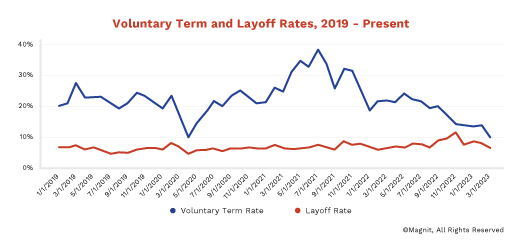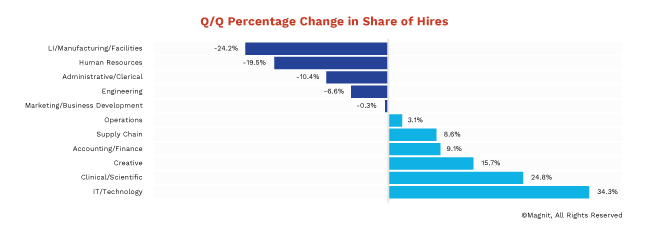4 Takeaways from Magnit’s Spring 2023 U.S. Labor Market Report
Dustin Burgess June 5 2023

How can we best navigate the current economic uncertainty, while preparing for an eventual rebound and resulting labor gaps? It’s a question many organizations are currently grappling with, as recessionary trends and economic uncertainties have continued to drive significant changes and challenges across the talent landscape through the first half of 2023.
For many leading businesses, contingent labor has emerged as a powerful channel to augment recession strategies, powering greater agility as businesses negotiate fluctuating employment rates and talent availability.
To help organizations better understand the current market and optimize the contingent workforce, Magnit analyzed billions of data points to uncover key trends and actionable insights for our latest U.S. Labor Market Report. Takeaways include:
1) Talent Is Becoming More Risk Averse as Worker Motivations Evolve
As layoffs have risen and economic volatility has continued, workers have taken a more cautious approach to leaving jobs, pushing the voluntary termination rate to an all-time low of 12.6% in Q1 2023 (see graph below). That’s less than half of the 29.1% rate experienced in 2021 during the height of the Great Resignation.

The ongoing economic uncertainty has also driven a shift in worker priorities, with focus on company reputation rising nearly 5% among workers in Q1 – more than three times the typical variability. To help assuage concerns over financial performance and layoffs, organizations should proactively communicate their business stability and recession strategy with candidates. (Related reading: “5 Tactics to Motivate the Contingent Talent You Need Right Now.”)
2) The Demand for Mission-Critical Roles Is Rising – Especially in Tech
While tech sector layoffs have dominated headlines, hiring for tech roles as a percentage of total hires actually saw the largest quarter-over-quarter increase in Q1, rising more than 34%. With organizations focused on mission-critical roles, manufacturing, HR and administrative roles saw the largest dips.

In an increasingly digital world, it’s likely that IT/technology talent will continue to experience heightened demand. To remain competitive, businesses should evaluate their compensation packages and flexible work offerings, as well as leveraging business intelligence tools to discover previously untapped talent sources.
3) Talent Pool Curation Should Be a Priority for Organizations
Although a longer period of low demand is forecast in 2023 versus the height of the COVID-19 pandemic, a rebound to high demand and fierce competition for talent is anticipated in 2024, particularly as organizations turn to contingent labor to fill gaps resulting from layoffs. Moreover, historical data demonstrates conversion rates typically fall during uncertainty only to ricochet to new highs later.
With this in mind, organizations that wish to emerge in the strongest position should take this time to prioritize skills analysis, strategic workforce planning and full-time conversion opportunities.
4) Hiring Less Experienced Workers Is Worth Considering, If Done Strategically
Many companies are reassessing what skills are truly needed and exploring the benefits of lower experience requirements. This approach can help lower costs, attract new talent and retain existing employees who may be seeking more flexibility or alternative work arrangements. However, there are associated costs to consider, such as the potential for increased turnover and lower productivity.
To shift to more of a skills-based approach to sourcing talent, organizations must deepen their understanding of their current skill inventory. While this has historically been a laborious task, emerging AI-powered technology is enabling sophisticated analysis while requiring fewer resources.
For more exclusive data and insights on these labor market trends and many other, check out our “Spring 2023 U.S. Labor Market Report.”
If you’re interested in learning more about how Magnit is helping organizations implement winning contingent workforce programs globally, please contact a Magnit representative at info@magnitglobal.com.
Disclaimer: The content in this blog post is for informational purposes only and cannot be construed as specific legal advice or as a substitute for legal advice. The blog post reflects the opinion of Magnit and is not to be construed as legal solutions and positions. Contact an attorney for specific advice and guidance for specific issues or questions.
